Rebooting Procurement Processes: Leveraging the Synergy of RPA and BPM for Optimized Efficiency
Abstract
1. Introduction
1.1. Research Gap and Objectives
1.2. Structure of the Paper
2. Research Background
2.1. Procurement and Procurement Process
2.2. Business Process Management
2.3. Robotic Process Automation
2.4. BPM and RPA in Procurement Transformation
3. Literature Review
3.1. Planning Phase
3.2. Conducting
3.3. Information Extraction
3.4. Findings
- RQ1. How can companies enhance their recognition and understanding of the value of Procurement processes?
- RQ2. What is the advantage of having procurement processes tailored for the organization?
- RQ3. What advantages do automating procurement processes bring to the organization?
- RQ4. Which procurement processes cannot be automated or semi-automated?
3.5. Discussion
4. Methodology
- Step 1—Problem Identification and Motivation: The research problem is clearly defined at this stage. The inefficiencies in procurement processes—in particular, the heavy reliance on manual interventions and the lack of standardization—were identified as the main bottlenecks in achieving operational efficiency. These issues increase processing time, reduce accuracy and increase compliance risks.
- Step 2—Definition of Objectives for a Solution: After identifying the problem, the objectives of the proposed solution are articulated. The main objective is to develop a system that reduces manual effort, improves data accuracy, standardizes this procurement process and is scalable for future growth. The solution should also guarantee compliance with audit requirements and improve the overall workflow control process.
- Step 3—Design and Development: The design and development phase involves the creation of an artifact that will address the research problem. In this case, the artifact is a two-part solution: (1) a Business Process Management (BPM) framework designed using Bizagi, which integrates heuristics for process improvement, and (2) a fully automated procurement process using an RPA for implementation.
- Step 4—Demonstration: In the demonstration phase, the artifact created is tested in a natural and simulated environment to verify its functionality and effectiveness in solving the defined problem. This stage aims to observe the performance of the proposed automation solution under practical conditions.
- Step 5—Evaluation: The evaluation phase focuses on assessing the effectiveness of the artifact in solving the problem. This stage involves comparing the artifact’s performance with the objectives defined earlier. Key metrics such as processing time, scalability and compliance will be analyzed to determine the success of the artifact.
- Step 6—Communication: The final stage involves disseminating the research results and the artifact by publishing this article.
5. Proposal
5.1. Goals and Requirements
- Enhance process efficiency: The procurement process in organizations typically faces bottlenecks due to a high dependency on manual tasks, stakeholder coordination, and fragmented data handling. Enhancing efficiency will reduce cycle time, improve stakeholder communication, and enhance data accuracy.
- Reduce manual interventions: Manual interventions are inherently prone to human errors, delays, and resource-intensive activities. Reducing manual activities will help organizations allocate resources to strategic tasks like vendor relationship management and strategic procurement planning.
- Ensure compliance with existing procurement policies: The complexity of procurement processes increases the likelihood of non-compliance risks. Ensuring automated alignment with procurement regulations, internal controls, and audit requirements is crucial for maintaining compliance and avoiding legal risks.
- Improved and Optimized Process: Applying process optimization heuristics to identify and eliminate redundant activities and bottlenecks before automation.
- Comprehensive Process Documentation: Establishing detailed documentation (Process Definition Document—PDD) to ensure the automated solution’s clarity, transparency, and maintainability.
- Process Modeling Standard: Using a standardized modeling notation (BPMN 2.0) to ensure clarity, consistency, and ease of integration within BPM systems.
5.2. Artifact Development
- Phase 1—Process Identification: The potential processes are assessed and documented for further development using criteria such as overall impact, manual entry intensity, and feasibility. In this initial phase, potential procurement processes are identified for automation based on the following criteria:
- ○
- Impact Analysis: Assessing the process’s strategic value and its overall contribution to organizational efficiency.
- ○
- Manual Effort Intensity: Quantifying and prioritizing processes with significant manual or repetitive tasks.
- ○
- Feasibility Evaluation: Considering technology availability, cost-effectiveness, compatibility with existing systems, and organizational readiness.
- Phase 2—Mapping and Standardizing: Using BPM tools, model the current process, identifying bottlenecks and redundancies. Subsequently, optimizing heuristics and a to-be process model will be applied. This phase involves comprehensive modeling and analysis of the current procurement process:
- ○
- Current-State Mapping: Utilize BPM tools to create detailed AS-IS process maps, explicitly identifying bottlenecks, redundancies, and inefficiencies.
- ○
- Optimization Heuristics Application: Applying recognized BPM heuristics (e.g., activity elimination, parallelism, and standardization heuristics) to propose optimized TO-BE scenarios [6].
- ○
- FValidation of Optimized Process: Stakeholder validation sessions to confirm that the new process aligns with organizational goals and compliance standards.
- Phase 3—Introduce process automation with RPA: Once the process has been standardized, RPA will be used to automate repetitive tasks. The automation will be designed to interact with existing systems like Power Apps, reducing time spent on manual tasks and improving data accuracy. This critical phase encompasses
- ○
- RPA Development: Implementation of RPA bots designed to automate routine tasks such as data entry, validation, supplier checks, and document handling.
- ○
- Integration with Existing Tools: Utilizing APIs or direct integration techniques with enterprise applications (e.g., Microsoft Power Apps, SAP ERP) to ensure smooth data exchange.
- ○
- Error and Exception Handling: Design robust mechanisms within RPA to manage exceptions, maintain logs, and ensure accountability.
- Phase 4—Test to Deploy: Different scenarios will be tested, and the prototype will ideally be improved. To validate the artifact, relevant stakeholders will be brought to the discussion to provide their insights and approval. The new process is then deployed. The testing and deployment phase include
- ○
- Scenario-Based Testing: Developing comprehensive testing scenarios, including stress tests, performance tests, and regression tests to validate bot reliability under different conditions.
- ○
- Stakeholder Engagement: Interactive workshops and validation sessions with procurement specialists and end-users to gather feedback and fine-tune the artifact.
- ○
- Deployment Planning: Detailed deployment plan, including rollback scenarios and contingency strategies.
- Phase 5—Governance: The deployed automation will be subject to governance and regular check. Any required update shall be conducted.
6. Demonstration
6.1. Use Case Context—Vendor Onboarding Process
Use Case: Data Input Detailed Overview
- Supplier Legal Name: The official legal name of the vendor.
- Supplier Country: The country where the vendor is based.
- System: The internal system used by the organization for vendor creation.
- Organization’s Country: The country of the internal paying entity, as the organization operates globally.
- Organization’s Company: The company code of the internal paying entity.
- Supplier Contact: The vendor’s point of contact.
- Business Approver: The individual responsible for approving the vendor setup.
- Organization’s Primary Contact: The liaison between the organization and the vendor.
- Market: The region in which the vendor operates.
- Master Category: The high-level procurement category.
- Category: The specific products or services provided by the vendor.
- Purchase Organization: The internal code of the paying entity.
- Attachment Requirement: Internal protocol requires an Excel form to be attached to the email request. This form must contain critical vendor details, including bank information, VAT number, and other relevant data for vendor creation.
6.2. Design
- It helps estimate the work involved in automating a process, allowing the evaluation of its complexity and the necessary interface components.
- It enables the developer to build the robot, helping align the manual execution of the process with the automated execution.
6.3. Tools
6.3.1. UIPath
6.3.2. Bizagi
6.4. AS-IS Process Modeling
6.5. Process Redesign
- Used Task-Level Redesign Heuristic:
- ○
- Elimination: Eliminate non-value-adding steps wherever these can be isolated. This heuristic will be applied to the “Send completion status to the requestor” task. By including the requestor’s email in Camunda’s loop message on ticket progress, the author will eliminate the necessity of informing the requestor parallelly about the raised ticket status.
- Used Flow-Level Redesign Heuristics:
- ○
- Parallelism Enhancement: Introducing parallel processing of tasks to reduce lead times and enhance throughput. “Retrieve Ticket ID and send to the requestor” and “Request Fulfilment” activities will be processed parallelly preceding the request completion.
- Used Process-Level Redesign Heuristics:
- ○
- Automation: Implementing automated solutions to repetitive or manual tasks to increase speed and accuracy. Considering the characteristics of the process, it was proposed to automate nearly the entire process.
- ○
- Standardization: Tailoring processes to specific needs while standardizing common elements to ensure consistency and quality. A form will be launched for the procurement team to fill in with the information provided by the requestor, which will then be saved as variables for the robot. The fields will always appear in the same order and contain the necessary information to proceed. This approach reduces the likelihood of missing information.
6.6. TO-BE Process Modeling
6.7. Building the RPA Process
6.7.1. Input Form
6.7.2. Save the Latest Email as a Variable
6.7.3. Use Browser Application and Perform Activities
- The “Use Browser Chrome” activity sets the context for subsequent actions within a Google Chrome browser window.
- The “Click” activity simulates a mouse click on specific User Interface elements within the web browser application. It is instrumental in interacting with buttons, links, checkboxes, and other clickable elements, triggering actions or navigating through interfaces.
- The “Type Into” activity facilitates the simulation of keyboard input by sending keystrokes to specified User Interface elements employed for entering text, or in this use case, variables previously saved entered in the input dialog within applications or web forms.
- The “Keyboard Shortcut” activity enables the automation of keyboard combinations within active applications. Used extensively in this workflow to perform actions typically executed via keyboard shortcuts.
- The “Delay” activity introduces a pause in workflow execution for a specified duration, measured in milliseconds. This activity is essential for managing timing requirements within automation processes, allowing synchronization with application loading times or external process dependencies.
6.7.4. Technical Implementation Details
| Listing 1. UiPath snippet—email validation logic (pseudo-code). |
| If Regex.IsMatch(emailInput, pattern) Then Proceed Else Throw Exception |
6.8. Discussion
Cycle Time Evaluation Using Flow Analysis
7. Evaluation
7.1. Identify Sample Frame and Moderator
7.2. Focus Group Planning and Execution
7.3. Results and Discussion
8. Conclusions, Limitations and Future Work
Author Contributions
Funding
Data Availability Statement
Acknowledgments
Conflicts of Interest
Abbreviations
| BPM | Business Process Management |
| CFG | Confirmatory Focus Group |
| DSRM | Design Science Research Methodology |
| P2P | Procure-to-Pay |
| PDD | Process Definition Document |
| PICOC | Population, Intervention, Comparison, Outcome, Context |
| RPA | Robotic Process Automation |
References
- Taylor, F.W. Principles and methods of scientific management. J. Account. 1911, 12, 3. [Google Scholar]
- Paim, R.; Caulliraux, H.M.; Cardoso, R. Process management tasks: A conceptual and practical view. Bus. Process Manag. J. 2008, 14, 694–723. [Google Scholar] [CrossRef]
- Broadbent, M.; Weill, P.; Clair, D.S. The Implications of Information Technology Infrastructure for Business Process Redesign. MIS Q. 1999, 23, 159–182. [Google Scholar] [CrossRef]
- Rudden, J. Making the Case for BPM: A Benefits Checklist. BPTrends 2007. [Google Scholar]
- vom Brocke, J.; Rosemann, M. Business Process Management. In Wiley Encyclopedia of Management; John Wiley & Sons, Ltd.: London, UK, 2015; pp. 1–9. [Google Scholar] [CrossRef]
- Dumas, M.; La Rosa, M.; Mendling, J.; Reijers, H.A. Fundamentals of Business Process Management; Springer: Berlin/Heidelberg, Germany, 2013. [Google Scholar] [CrossRef]
- Ravesteyn, P.; Batenburg, R. Surveying the critical success factors of BPM-systems implementation. Bus. Process Manag. J. 2010, 16, 492–507. [Google Scholar] [CrossRef]
- de Morais, R.M.; Kazan, S.; de Pádua, S.I.D.; Costa, A.L. An analysis of BPM lifecycles: From a literature review to a framework proposal. Bus. Process Manag. J. 2014, 20, 412–432. [Google Scholar] [CrossRef]
- Cousins, P.; Lamming, R.; Squire, B. Strategic Supply Management: Principles, Theories and Practice; Pearson Education: Upper Saddle River, NJ, USA, 2008. [Google Scholar]
- Ramsay, J.; Croom, S. The impact of evolutionary and developmental metaphors on Purchasing and Supply Management: A critique. J. Purch. Supply Manag. 2008, 14, 192–204. [Google Scholar] [CrossRef]
- Bäckstrand, J.; Suurmond, R.; van Raaij, E.; Chen, C. Purchasing process models: Inspiration for teaching purchasing and supply management. J. Purch. Supply Manag. 2019, 25, 100577. [Google Scholar] [CrossRef]
- Monczka, R.M.; Handfield, R.B.; Giunipero, L.C.; Patterson, J.L. Purchasing & Supply Chain Management. Cengage Learning. 2021. Available online: https://thuvienso.hoasen.edu.vn/handle/123456789/12731 (accessed on 18 April 2024).
- Baird, K.; Hu, K.J.; Reeve, R. The relationships between organizational culture, total quality management practices and operational performance. Int. J. Oper. Prod. Manag. 2011, 31, 789–814. [Google Scholar] [CrossRef]
- Moffitt, K.C.; Rozario, A.M.; Vasarhelyi, M.A. Robotic Process Automation for Auditing. J. Emerg. Technol. Account. 2018, 15, 1–10. [Google Scholar] [CrossRef]
- Leno, V.; Dumas, M.; Polyvyanyy, A.; Maggi, F.M.; Rosa, M.L. Robotic Process Mining: Vision and Challenges. Bus. Inf. Syst. Eng. 2021, 63, 301–314. [Google Scholar] [CrossRef]
- Tripathi, S.; Gupta, M. A framework for procurement process re-engineering in Industry 4.0. Bus. Process Manag. J. 2020, 27, 439–458. [Google Scholar] [CrossRef]
- Agostinelli, S.; Marrella, A.; Mecella, M. Research Challenges for Intelligent Robotic Process Automation. In Business Process Management Workshops; Lecture Notes in Business Information, Processing; Di Francescomarino, C., Dijkman, R., Zdun, U., Eds.; Springer International Publishing: Cham, Switzerland, 2019; pp. 12–18. [Google Scholar] [CrossRef]
- Okoli, C. A Guide to Conducting a Standalone Systematic Literature Review. Commun. Assoc. Inf. Syst 2015, 37, 43. [Google Scholar] [CrossRef]
- Webster, J.; Watson, R.T. Analyzing the Past to Prepare for the Future: Writing a Literature Review. MIS Q. 2002, 26, xiii–xxiii. [Google Scholar]
- Kitchenham, B.; Charters, S. Guidelines for Performing Systematic Literature Reviews in Software Engineering; Keele University: Staffordshire, UK; Durham University: Durham, UK, 2007; Volume 2. [Google Scholar]
- Petticrew, M.; Roberts, H. Systematic Reviews in the Social Sciences: A Practical Guide; John Wiley & Sons: New York, NY, USA, 2008. [Google Scholar]
- Chams-Anturi, O.; Soto-Ferrari, M.; Gomez, A.; Escorcia-Caballero, J.; Romero-Rodriguez, D.; Casile, M. A Comprehensive Business Process Management Application to Evaluate and Improve the Importations Practices on Big-box Stores. Oper. Supply Chain Manag. Int. J. 2022, 15, 164–173. [Google Scholar] [CrossRef]
- Lazareva, N.; Karasevskis, K.; Girjatovcs, A.; Kuznecova, O. Business Process Automation in Retail. In Proceedings of the 2022 63rd International Scientific Conference on Information Technology and Management Science of Riga Technical University (ITMS), Riga, Latvia, 6–7 October 2022; pp. 1–5. [Google Scholar] [CrossRef]
- Impedovo, A.; Barracchia, E.P.; Rizzo, G. Intelligent Robotic Process Automation for Supplier Document Management on E-Procurement Platforms. In Machine Learning, Optimization, Data Science; Lecture Notes in Computer, Science; Nicosia, G., Ojha, V., La Malfa, E., La Malfa, G., Pardalos, P., Di Fatta, G., Giuffrida, G., Umeton, R., Eds.; Springer Nature: Cham, Switzerland, 2023; pp. 156–166. [Google Scholar] [CrossRef]
- Berger, S.L.T.; Frazzon, E.M.; Danielli, A.M.C. Pull-production system in a lean supply chain: A performance analysis utilizing the simulation-based optimization. In Proceedings of the 2018 13th IEEE International Conference on Industry Applications (INDUSCON), Sao Paulo, Brazil, 2–14 November 2018; pp. 870–874. [Google Scholar] [CrossRef]
- Ylä-Kujala, A.; Kedziora, D.; Metso, L.; Kärri, T.; Happonen, A.; Piotrowicz, W. Robotic process automation deployments: A step-by-step method to investment appraisal. Bus. Process Manag. J. 2023, 29, 163–187. [Google Scholar] [CrossRef]
- Ore, A.; Kuznecova, O.; Jegorova, A. Self-managed Organization: A Role of Business Process Management. In Proceedings of the 2021 62nd International Scientific Conference on Information Technology and Management Science of Riga Technical University (ITMS), Riga, Latvia, 14–15 October 2021; pp. 1–6. [Google Scholar] [CrossRef]
- Bag, S.; Wood, L.C.; Mangla, S.K.; Luthra, S. Procurement 4.0 and its implications on business process performance in a circular economy. Resour. Conserv. Recycl. 2020, 152, 104502. [Google Scholar] [CrossRef]
- Chopra, A. Technology in Procurement and Supply as Prevalent Today and Scope for Future. In Proceedings of the 2018 International Conference on Automation and Computational Engineering (ICACE), Greater Noida, India, 3–4 October 2018; pp. 216–223. [Google Scholar] [CrossRef]
- Khan, A.A.; Abonyi, J. Information sharing in supply chains—Interoperability in an era of circular economy. Clean. Logist. Supply Chain 2022, 5, 100074. [Google Scholar] [CrossRef]
- Dossou, P.-E. Using industry 4.0 concepts and theory of systems for improving company supply chain: The example of a joinery. Procedia Manuf. 2019, 38, 1750–1757. [Google Scholar] [CrossRef]
- Isaksson, A.J.; Harjunkoski, I.; Sand, G. The impact of digitalization on the future of control and operations. Comput. Chem. Eng. 2018, 114, 122–129. [Google Scholar] [CrossRef]
- Parker, S.K.; Grote, G. Automation Algorithms, and Beyond: Why Work Design Matters More Than Ever in a Digital World. Appl. Psychol. 2022, 71, 1171–1204. [Google Scholar] [CrossRef]
- Mukherjee, D.; Ahmad, S. Impact of Digital Transformation in Sourcing & Tender Management Processes on Employee Job Satisfaction—A Study on Malaysian Multinational Electricity Company. In Proceedings of the 2023 1st International Conference on Intelligent Computing and Research Trends (ICRT), Roorkee, India, 3–4 February 2023; pp. 1–7. [Google Scholar] [CrossRef]
- Chandrasekara, S.; Wickramarachchi, R. A Literature-Based Survey on Industry 4.0 Technologies for Procurement Optimization. 2020. Available online: http://repository.kln.ac.lk/handle/123456789/25295 (accessed on 20 November 2023).
- Singh, K.; Goyal, S.B.; Bedi, P. The Role of Artificial Intelligence and Machine Learning in Supply Chain Management and its Task Model. In Proceedings of the 2020 3rd International Conference on Intelligent Sustainable Systems (ICISS), Thoothukudi, India, 3–5 December 2020; pp. 616–621. [Google Scholar] [CrossRef]
- Bienhaus, F.; Haddud, A. Procurement 4.0: Factors influencing the digitization of procurement and supply chains. Bus. Process Manag. J. 2018, 24, 965–984. [Google Scholar] [CrossRef]
- Viale, L.; Zouari, D. Impact of digitalization on procurement: The case of robotic process automation. Supply Chain Forum Int. J. 2020, 21, 185–195. [Google Scholar] [CrossRef]
- Flechsig, C. The Impact of Intelligent Process Automation on Purchasing and Supply Management—Initial Insights from a Multiple Case Study. In Logistics Management; Lecture Notes in Logistics; Buscher, U., Lasch, R., Schönberger, J., Eds.; Springer International Publishing: Cham, Switzerland, 2021; pp. 67–89. [Google Scholar] [CrossRef]
- Najat, T.; Eddine, E.M.A. Digitalization and Business Automation for an Effective Supply Chain Integration: A literature review. In Proceedings of the 2024 IEEE 15th International Colloquium on Logistics and Supply Chain Management (LOGISTIQUA), Sousse, Tunisia, 2–4 May 2024; pp. 1–7. [Google Scholar] [CrossRef]
- Zhang, L.; Mingxia, M. Leveraging AI and RPA in SAP Variant Configuration: A New Paradigm for Efficient Supply Chain Management. Balt. Multidiscip. Res. Lett. J. 2024, 1, 64–70. [Google Scholar]
- Zhang, W.; Chen, L. Artificial Intelligence and RPA-Enabled SAP Variant Configuration: Transforming Modern Supply Chain Management. Balt. Multidiscip. Res. Lett. J. 2024, 1, 42–48. [Google Scholar]
- Subramanian, P.; Singh, R. Artificial Intelligence in International and National Project Management: Strategic Innovations for Success in the US and Beyond. Balt. Multidiscip. Res. Lett. J. 2024, 1, 42–48. [Google Scholar]
- Gul, R.S.; Allhibi, H.; Alshamri, F.M.S. Intelligent Control Systems for Automation: Integrating Artificial Intelligence in Electrical Engineering Applications. Balt. Multidiscip. Res. Lett. J. 2024, 1, 9–15. [Google Scholar]
- Peffers, K.; Tuunanen, T.; Rothenberger, M.A.; Chatterjee, S. A Design Science Research Methodology for Information Systems Research. J. Manag. Inf. Syst. 2007, 24, 45–77. [Google Scholar] [CrossRef]
- Marcilly, R.; Ammenwerth, E.; Roehrer, E.; Pelayo, S.; Vasseur, F.; Beuscart-Zéphir, M.-C. Usability Flaws in Medication Alerting Systems: Impact on Usage and Work System. Yearb. Med. Inform. 2015, 24, 55–67. [Google Scholar] [CrossRef]
- Sivaji, A.; Soo, S.-T.; Abdullah, M.R. Enhancing the Effectiveness of Usability Evaluation by Automated Heuristic Evaluation System. In Proceedings of the 2011 Third International Conference on Computational Intelligence, Communication Systems and Networks, Bali, Indonesia, 26–28 July 2011; pp. 48–53. [Google Scholar] [CrossRef]
- Anagnoste, S. Robotic Automation Process—The next major revolution in terms of back office operations improvement. Proc. Int. Conf. Bus. Excell. 2017, 11, 676–686. [Google Scholar] [CrossRef]
- Yatskiv, N.; Yatskiv, S.; Vasylyk, A. Method of Robotic Process Automation in Software Testing Using Artificial Intelligence. In Proceedings of the 2020 10th International Conference on Advanced Computer Information Technologies (ACIT), Deggendorf, Germany, 16–18 September 2020; pp. 501–504. [Google Scholar] [CrossRef]
- BluePrism. Blue Prism—Creating a Process Definition Document. 2021. Available online: https://portal.blueprism.com/system/files/2018-03/Blue%20Prism%20-%20Creating%20a%20Process%20Definition%20Document_0.pdf (accessed on 5 January 2025).
- UiPath. Task Capture—Details about the PDD. Available online: https://docs.uipath.com/task-capture/standalone/2022.4/user-guide/details-about-the-pdd (accessed on 19 May 2024).
- Gartner. Magic Quadrant for Robotic Process Automation. Available online: https://www.gartner.com/en/documents/4595599 (accessed on 24 June 2024).
- D’avila, C.F.M.; Costa, V.d.S.; Lopes, B.J.d.A.C.; Roberto, J.C.A.; Pinto, J.R.L., Jr. Proposta de implementação de software de gestão para melhoria da eficiência operacional: Um estudo de caso em uma clinical oftalmológica em Manaus. Cad. Pedagógico 2023, 20, 40–62. [Google Scholar] [CrossRef]
- Maukar, A.L.; Fiasta, J.I. Business Process Improvement for Reducing Delay in the Material Document Issue Process in the Fertiliser Manufacturing Industry. J. Sci. Appl. Eng. 2023, 6. [Google Scholar] [CrossRef]
- Pamungkas, Y.C.; Fajar, A.N. Business Process Improvement Using Bpi Method in the Implementation of Communication Network Device to Support Online Bank Branch Office and ATMs. J. Inf. Syst. Inform. 2022, 4, 607–635. [Google Scholar] [CrossRef]
- Panduwinasari, E.; Eltivia, N.; Afandi, A. Business process modeling with cloud computing support: A case study. Int. J. Res. Bus. Soc. Sci. 2021, 10, 512–519. [Google Scholar] [CrossRef]
- Vasilecas, O.; Kalibatiene, D.; Lavbič, D. Rule- and context-based dynamic business process modelling and simulation. J. Syst. Softw. 2016, 122, 1–15. [Google Scholar] [CrossRef]
- Bizagi.com. Why Bizagi? 2024. Available online: https://www.bizagi.com/pt/por-que-bizagi (accessed on 23 December 2024).
- SoftwareReviews. Top Business Process Management Software Awards 2024. Available online: https://www.softwarereviews.com/awards/data-quadrant-awards-2024-business-process-management (accessed on 24 June 2024).
- Eekels, J.; Roozenburg, N.F.M. A methodological comparison of the structures of scientific research and engineering design: Their similarities and differences. Des. Stud. 1991, 12, 197–203. [Google Scholar] [CrossRef]
- Peffers, K.; Tuunanen, T. Planning for IS applications: A practical, information theoretical method and case study in mobile financial services. Inf. Manag. 2005, 42, 483–501. [Google Scholar] [CrossRef]
- Hevner, A.R.; March, S.T.; Park, J.; Ram, S. Design Science in Information Systems Research. MIS Q. 2004, 28, 75–105. [Google Scholar] [CrossRef]
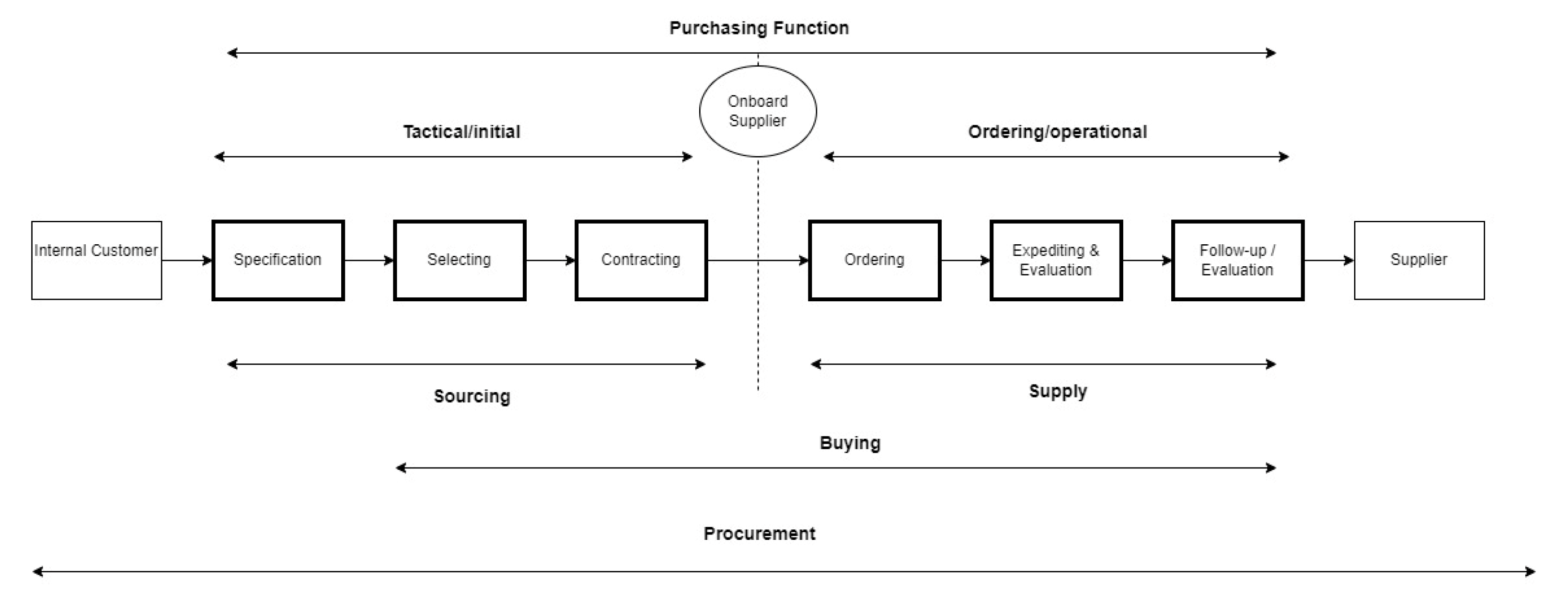


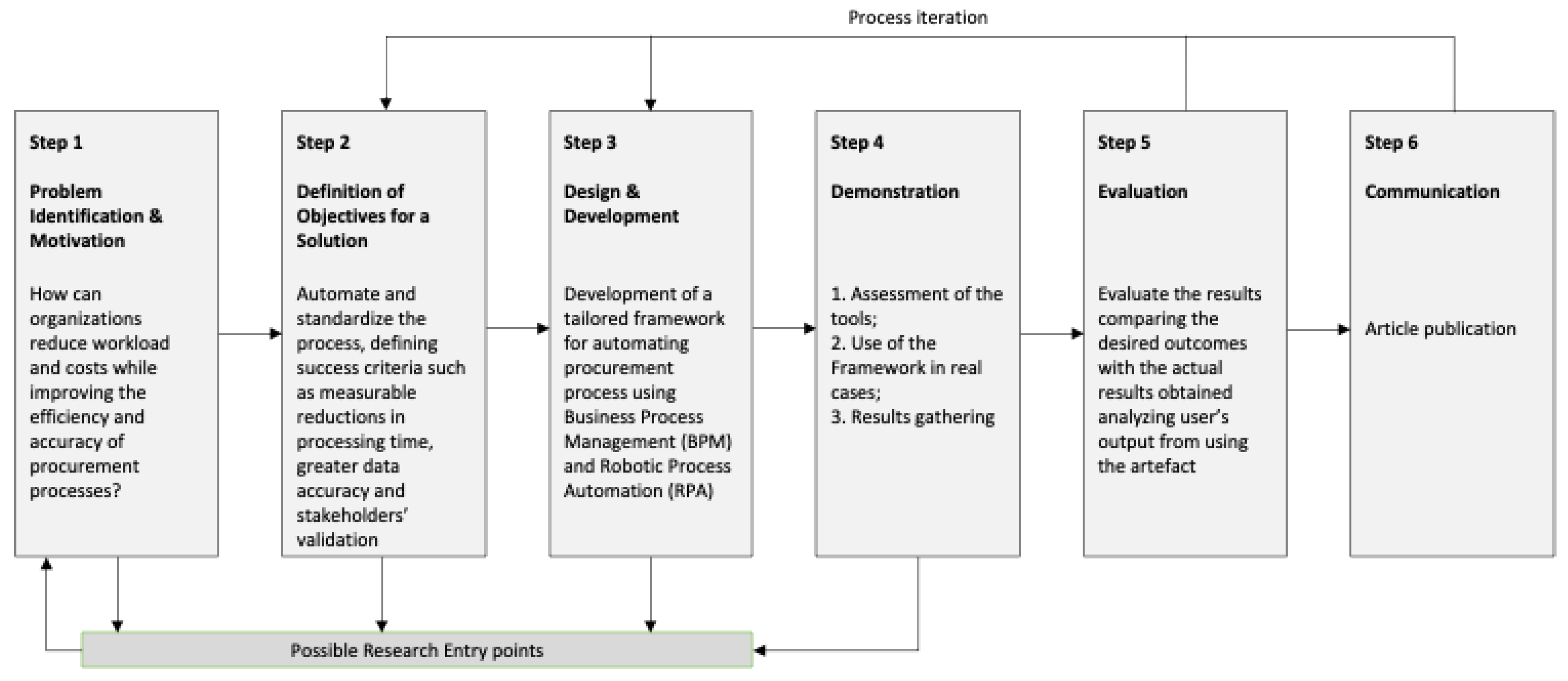
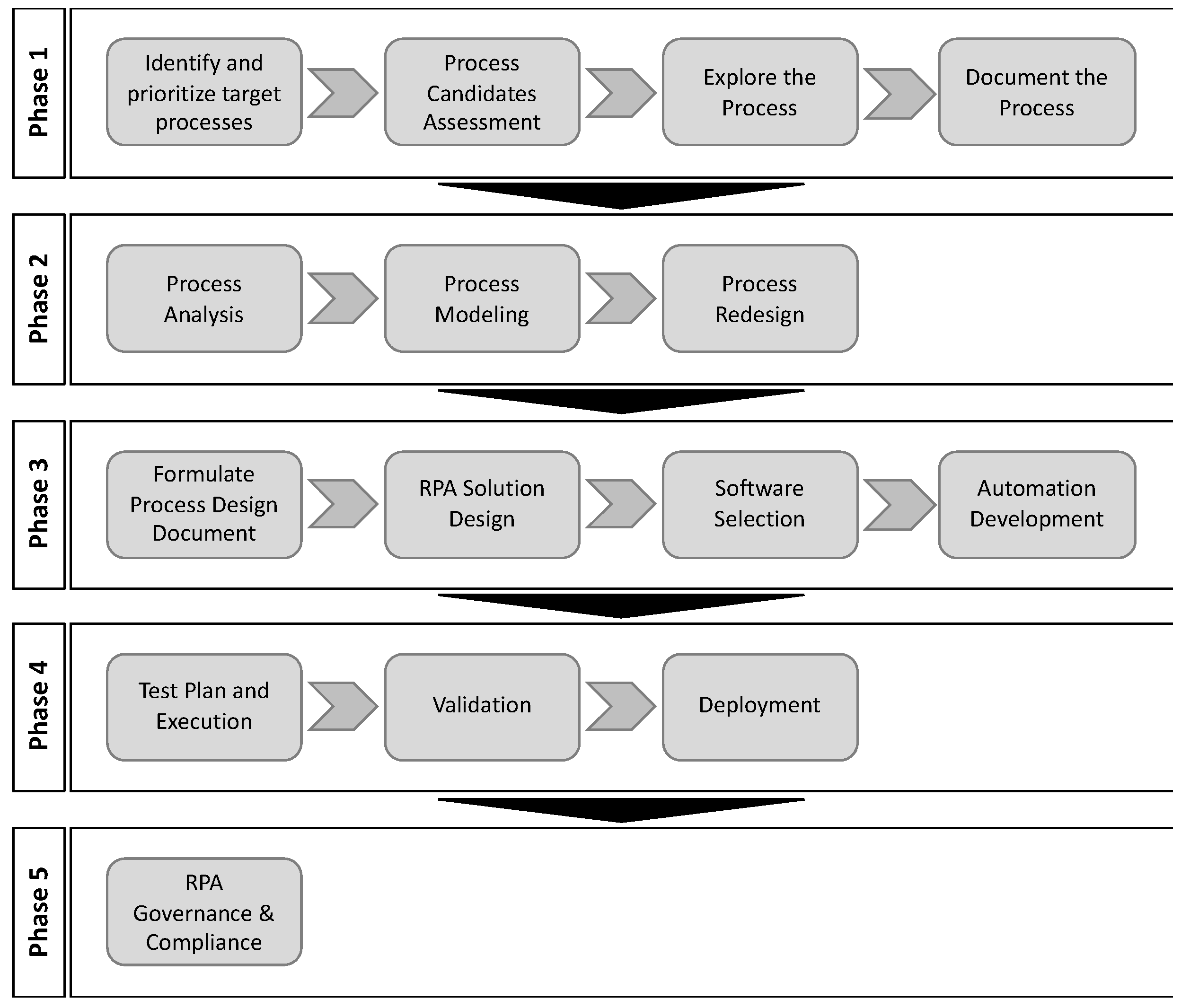

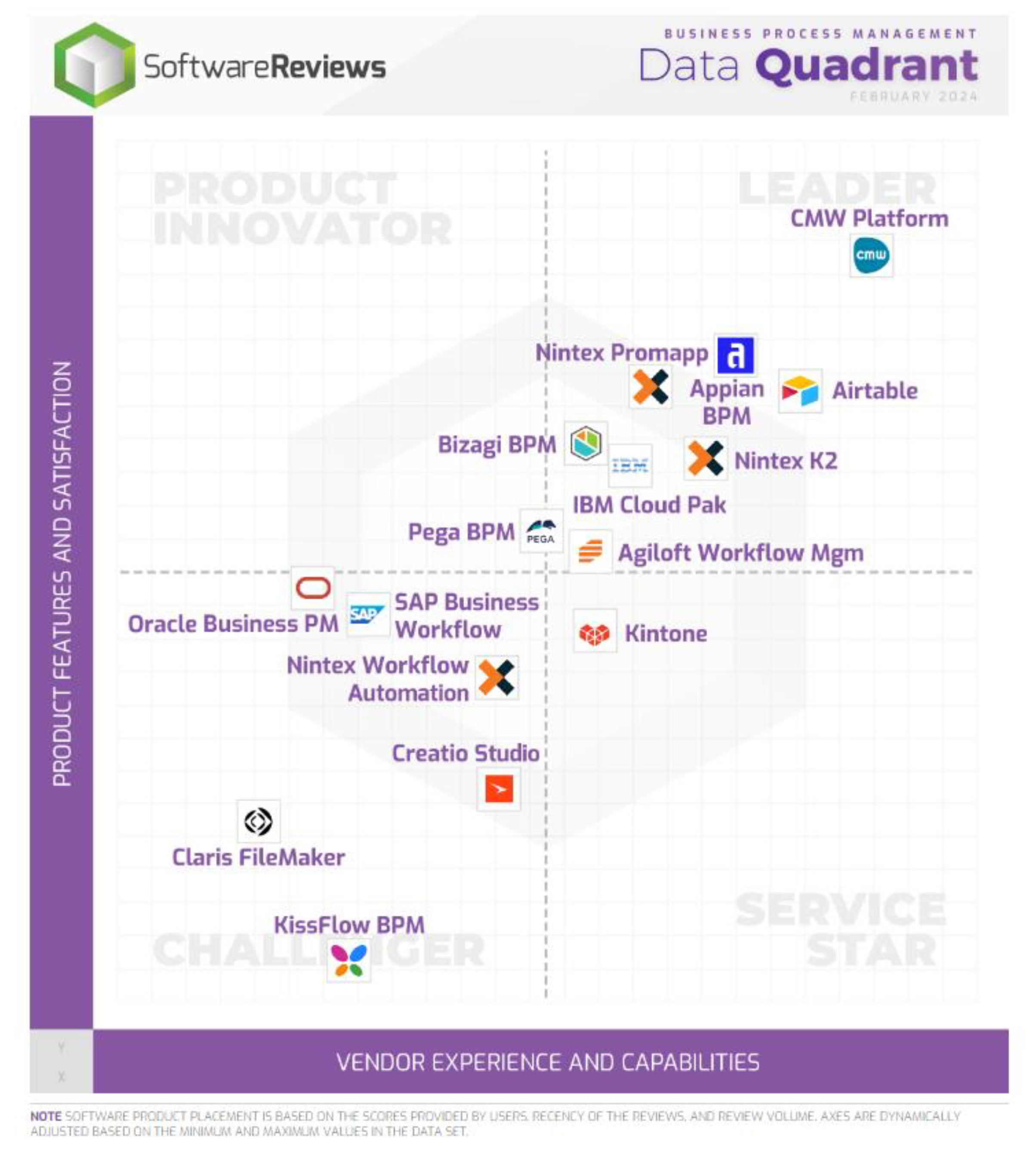
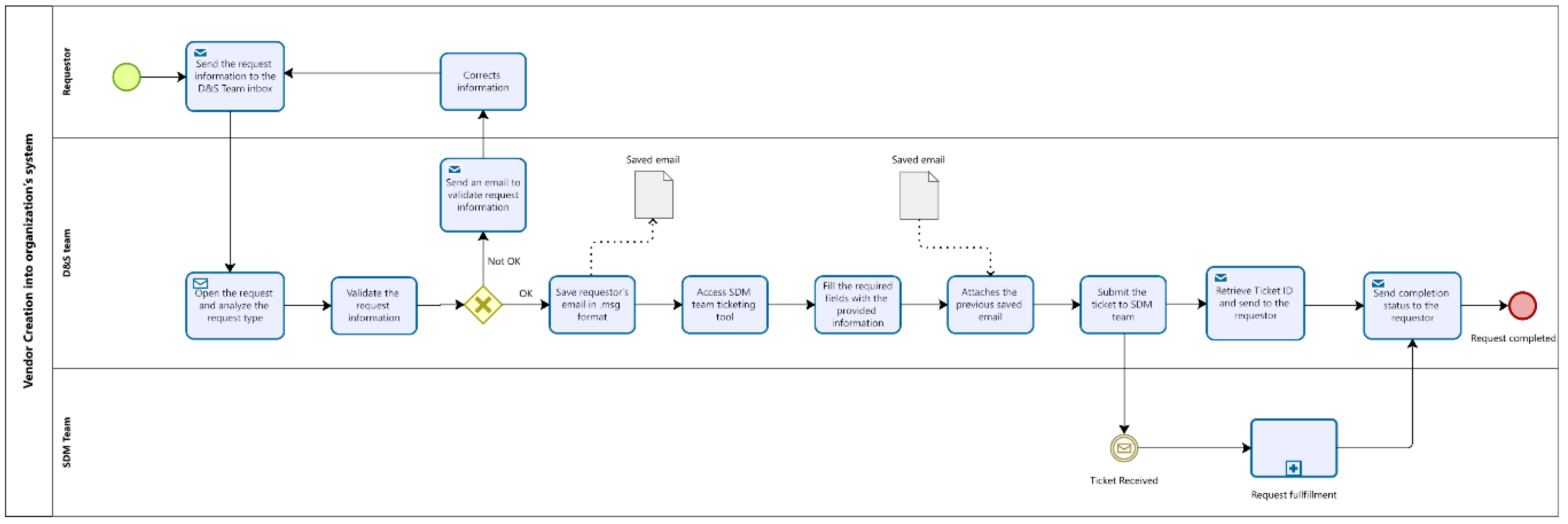
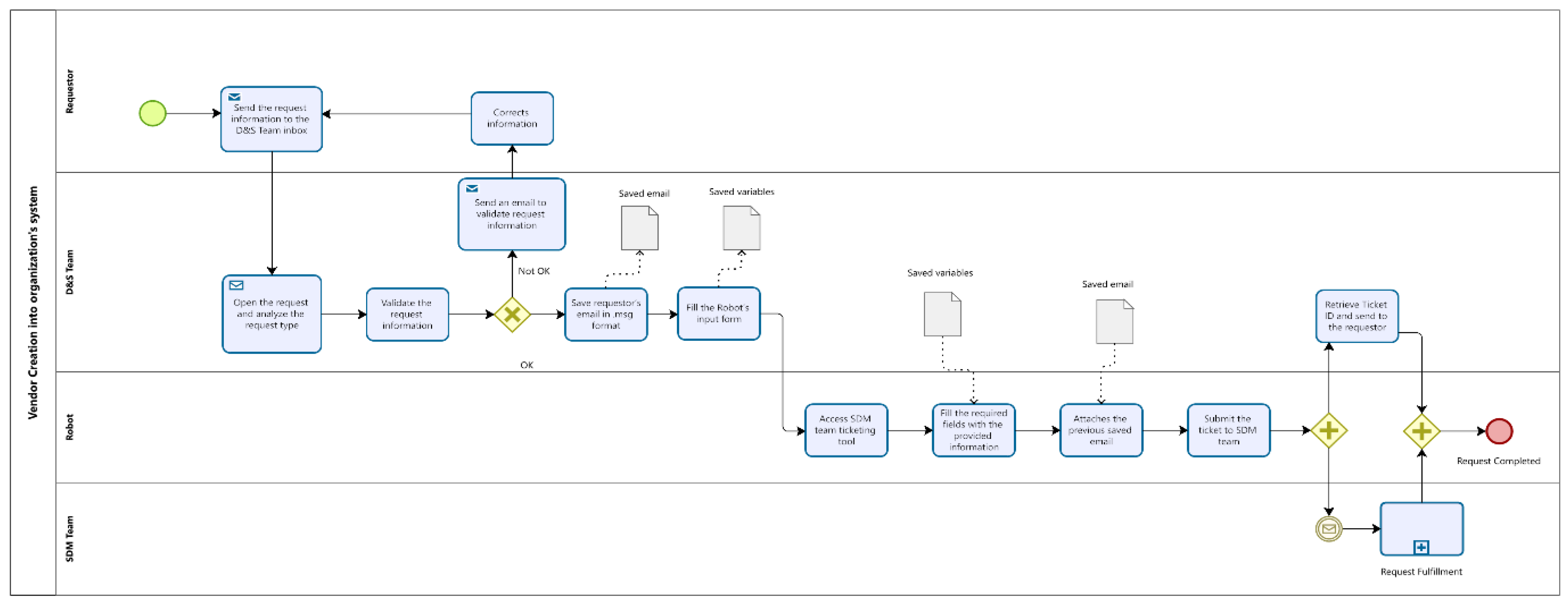



| Criteria | Description |
|---|---|
| Population: What is the problem/What are the groups involved? | The problem is the poor recognition and understanding of the value of procurement processes and the need for more awareness of the potential of automation and modeling to optimize procurement processes that require much manual intervention. The population can be any organization that has a procurement department. |
| Intervention: software/tool to address a specific issue. | A TO-BE model will be deployed using BPMN language and BPM heuristics and will be recurring with UiPath to automate potential tasks. |
| Comparison: The software/tool with which the intervention is being compared. | A comparison will be made between the AS-IS model and the state-of-the-art model. A CFG will also be conducted to compare the impact of the suggested changes. |
| Outcomes: Factors of importance to practitioners such as improved reliability, reduced production costs, and reduced time to market [20]. | This kind of intervention can provide alternatives to the repetitive and manual tasks that procurement employees go through daily with inherent cost reduction and reduced time to market. |
| Context: the context in which the comparison takes place [20]. | The comparison occurs in an industry once the work is compared with the actual state of the art in a specific company. |
| Id. | Question |
|---|---|
| RQ1 | How can companies enhance their recognition and understanding of the value of procurement processes? |
| RQ2 | What is the advantage of having procurement processes tailored for the organization? |
| RQ3 | What advantages do automating procurement processes bring to the organization? |
| RQ4 | Which procurement processes cannot be automated or semi-automated? |
| Resource Database | Resource URL |
|---|---|
| Scopus | https://www.scopus.com/ |
| Web of Science | https://www.webofscience.com/ |
| Inclusion Criteria | Exclusion Criteria |
|---|---|
| Evidence of Employing Robotic Process Automation (RPA) in procurement | Publications from or before 2017 with peer review |
| Evidence of employing Business Process Management (BPM) in procurement | Language distinct to English |
| BPM or RPA applied to fields other than procurement | |
| Publication not peer-reviewed | |
| Q3 or Q4 journals |
| Search String |
|---|
| (“Procurement” OR “Sourcing” OR “Supply Chain”) AND (“Automation” OR “Robotic Process Automation” OR “Intelligent Process Automation”) AND (“Business Process Management” OR “Optimization” OR “ Business Modeling”) |
| Authors | Title | Source | Year |
|---|---|---|---|
| [22] | A Comprehensive Business Process Management Application to Evaluate and Improve the Importations Practices on Big-box Stores | Operations and Supply Chain Management—An International Journal | 2022 |
| [16] | A framework for procurement process re-engineering in Industry 4.0 | Business Process Management Journal | 2021 |
| [23] | Business Process Automation in Retail | 2022 63rd International Scientific Conference on Information Technology and Management Science of Riga Technical University (ITMS) | 2022 |
| [24] | Intelligent Robotic Process Automation for Supplier Document Management on E-Procurement Platforms | Machine Learning, Optimization, and Data Science, LOD 2022, Pt I | 2023 |
| [25] | Pull-production system in a lean supply chain: a performance analysis utilizing the simulation-based optimization | 2018 13th IEEE International Conference on Industry Applications (INDUSCON) | 2018 |
| [26] | Robotic process automation deployments: a step-by-step method to investment appraisal | Business Process Management Journal | 2023 |
| [27] | Self-managed Organization: A Role of Business Process Management | 2021 62nd International Scientific Conference on Information Technology and Management Science of Riga Technical University (ITMS) | 2021 |
| [28] | Procurement 4.0 and its implications on business process performance in a circular economy | Resources, Conservation and Recycling | 2020 |
| [29] | Technology in Procurement and Supply as Prevalent Today and Scope for Future | 2018 International Conference on Automation and Computational Engineering (ICACE) | 2018 |
| [30] | Information sharing in supply chains-Interoperability in an era of circular economy | Cleaner Logistics and Supply Chain | 2022 |
| [31] | Using Industry 4.0 concepts and theory of systems for improving company supply chain: the example of a joinery | 29th International Conference on Flexible Automation and Intelligent Manufacturing - FAIM 2019: Beyond Industry 4.0: Industrial Advances, Engineering Education, and Intelligent Manufacturing | 2019 |
| [32] | The impact of digitalization on the future of control and operations | Computers and Chemical Engineering | 2018 |
| [33] | Automation, Algorithms, and Beyond: Why Work Design Matters More Than Ever in a Digital World | Applied Psychology: An International Review | 2022 |
| [34] | Impact of Digital Transformation in Sourcing and Tender Management Processes on Employee Job Satisfaction—A Study on Malaysian Multinational Electricity Company | 2023 1st International Conference on Intelligent Computing and Research Trends, ICRT 2023 | 2023 |
| [35] | A literature-based survey on Industry 4.0 technologies for procurement optimization | Proceedings of the International Conference on Industrial Engineering and Operations Management | 2020 |
| [36] | The role of artificial intelligence and machine learning in supply chain management and its task model | Proceedings of the 3rd International Conference on Intelligent Sustainable Systems, ICISS 2020 | 2020 |
| [37] | Procurement 4.0: factors influencing the digitization of procurement and supply chains | Business Process Management Journal | 2018 |
| [38] | Impact of digitalization on Procurement: the case of robotic process automation | Supply Chain Forum: An International Journal | 2020 |
| [39] | The impact of Intelligent Process Automation on purchasing and supply management—Initial insights from a multiple case study | Springer International Publishing | 2021 |
| [40] | Digitalization and Business Automation for an Effective Supply Chain Integration: A literature review | Proceedings of the I EEE 15th International Colloquium on Logistics and Supply Chain Management (LOGISTIQUA) | 2024 |
| [41] | Leveraging AI and RPA in SAP Variant Configuration: A New Paradigm for Efficient Supply Chain Management | Baltic Multidisciplinary Research Letters Journal | 2024 |
| [42] | Artificial Intelligence and RPA-Enabled SAP Variant Configuration: Transforming Modern Supply Chain Management | Baltic Multidisciplinary Research Letters Journal | 2024 |
| [43] | Artificial Intelligence in International and National Project Management: Strategic Innovations for Success in the US and Beyond | Baltic Multidisciplinary Research Letters Journal | 2024 |
| [44] | Intelligent Control Systems for Automation: Integrating Artificial Intelligence in Electrical Engineering Applications | Baltic Multidisciplinary Research Letters Journal | 2024 |
| Requirement | Addressed by |
|---|---|
| Enhance process efficiency | Process Automation |
| Reduce manual interventions | Process Automation |
| Ensure compliance with existing procurement policies | Process Automation |
| Improved and optimized process | BPM’s Heuristics application |
| Process documentation | PDD Template |
| Process modeling | BPMN 2.0 |
| Index | Description |
|---|---|
| 1. Introduction | Brief process description, mentioning how it is manually executed. |
| 2. Roles and responsibilities | Actors’ identification of the manual and automatized process. Brief roles description |
| 3. Process framework | Process details. |
| 4.1 AS-IS Process Discovery | Execution tools. |
| 4.2 AS-IS Process Modeling | Identification and description of the activities and tasks of the process, with a high level of detail; use of screenshots whenever necessary, specifying data handling or uploading; |
| 4.3 Process Redesign | Insertion of the process model in BPMN 2.0 |
| 4.4 TO-BE Process Modeling | BPM’s Heuristics application |
| 5. Manually Performed Tasks | Insertion of the process model in BPMN 2.0 created in step 4.3 of the current PDD and identification of automated and non-automated activities. |
| Index | Description | Default Value |
|---|---|---|
| latestFileDate | System.DateTime | 1 January 1753 |
| latestFile | String | N/A |
| Activity Name | Sub-Activity Name | VB Code |
|---|---|---|
| IF | Condition | CurrentFile.CreationTime > latestFileDate |
| Set Variable Value | Save to | latestFile |
| Set Variable Value | Value to save | CurrentFile.FullName |
| Set Variable Value (1) | Save to | latestFileDate |
| Set Variable Value (1) | Value to save | CurrentFile.CreationTime |
| Variable | Observed Result |
|---|---|
| Cycle Time before heuristics and automation (1) | 8 min and 13 s (493 s) |
| Cycle Time after heuristics and automation (2) | 4 min and 3 s (243 s) |
| Monthly requests # (3) | 330 |
| (3) × (1) | 45 h, 1 min, and 30 s (162,690 s) |
| (3) × (2) | 22 h, 36 min, and 30 s (80,190 s) |
| Monthly cycle time difference | 22 h, 36 min, and 30 s (82,500 s) |
| Item | Value |
|---|---|
| Number of Groups | 1 |
| Group Size | 5 |
| Source of participants | procurement Team—P2P Department |
| Moderator | Authors |
| Participant | Experience | Current Position |
|---|---|---|
| #1 | Over 5 years of experience managing purchasing operations, including supplier management and compliance checks | Sourcing Specialist |
| #2 | Former owner of the vendor onboarding process | Junior Sourcing Specialist |
| #3 | Former owner of the vendor onboarding process | Sourcing Specialist |
| #4 | Current owner of the vendor onboarding process | Operational Sourcing Specialist |
| #5 | Current owner of the vendor onboarding process | Operational Sourcing Specialist |
| Question | Description |
|---|---|
| VQ1 | Do you find the proposed framework helpful? Why or why not? (Objective: Assess utility in daily tasks) |
| VQ2 | Would you consider implementing the proposed framework? Please explain your reasons. (Objective: Evaluate viability) |
| VQ3 | Do you have any recommendations or suggestions for improving the proposed framework? (Objective: Gather suggestions and criticism) |
| Question | Consensus | Detailed Feedback |
|---|---|---|
| VQ1 | All participants consider the framework very useful. The proposed framework was considered helpful by unanimous voting. Reasons such as efficiency, clarity and automation reduce the workload of the D&S Team. The framework reduces back-and-forth emails and automates the field filling, saving time per consensus. The current tools used were compared, and it was concluded that the proposed framework is more responsive and user-friendly than existing tools. | One participant pointed out that the framework would eliminate the need for vendor creation requests via email, thus reducing the workload on the D&S Team. Other participants mentioned that the automated process would allow team members to focus on checking and verifying information rather than spending time on manual data entry. Overall, the feedback was overwhelmingly positive, with participants appreciating the framework’s potential to enhance their workflow and reduce operational inefficiencies. |
| VQ2 | All participants would consider implementing the proposed framework. By unanimous opinion, the proposed framework should be implemented. Reasons such as value addition and future use were mentioned. Participants also expressed strong support, indicating a consensus on its potential benefits. Notably, a desire among participants to use the framework in their daily operations was registered, suggesting a high level of acceptance and readiness for adoption. | One participant emphasized that the framework offered a clear value-add to their current processes, making it worth considering for implementation. Another participant agreed, expressing confidence in the framework’s potential benefits and stating they would like to see it in use as soon as possible. The unanimous agreement and positive outlook on the framework’s implementation reflect its perceived utility and the participants’ readiness to adopt it. |
| VQ3 | The participants suggested adding a “Comments” section as an input field to be later reflected in the PowerApps form to provide additional information when necessary. There was a concern about requestors needing to fill out the required fields correctly. Making the process as intuitive as possible is suggested to ensure accurate and complete information. Some participants also recommended further developing the tool to enhance its functionality and address any potential issues that might arise from improper field completion. | One participant noted that the framework should include a “Comments” field for additional input, which could be crucial for specific requests. Another participant mentioned that while the framework makes it obligatory to fill in required fields, it should also guide users on how to fill them correctly to avoid errors. The recommendation for further development was seen as a proactive approach to ensuring the tool remains practical and user-friendly. |
Disclaimer/Publisher’s Note: The statements, opinions and data contained in all publications are solely those of the individual author(s) and contributor(s) and not of MDPI and/or the editor(s). MDPI and/or the editor(s) disclaim responsibility for any injury to people or property resulting from any ideas, methods, instructions or products referred to in the content. |
© 2025 by the authors. Licensee MDPI, Basel, Switzerland. This article is an open access article distributed under the terms and conditions of the Creative Commons Attribution (CC BY) license (https://creativecommons.org/licenses/by/4.0/).
Share and Cite
Santos, S.; Santos, V.; Mamede, H.S. Rebooting Procurement Processes: Leveraging the Synergy of RPA and BPM for Optimized Efficiency. Electronics 2025, 14, 2694. https://doi.org/10.3390/electronics14132694
Santos S, Santos V, Mamede HS. Rebooting Procurement Processes: Leveraging the Synergy of RPA and BPM for Optimized Efficiency. Electronics. 2025; 14(13):2694. https://doi.org/10.3390/electronics14132694
Chicago/Turabian StyleSantos, Simão, Vitor Santos, and Henrique S. Mamede. 2025. "Rebooting Procurement Processes: Leveraging the Synergy of RPA and BPM for Optimized Efficiency" Electronics 14, no. 13: 2694. https://doi.org/10.3390/electronics14132694
APA StyleSantos, S., Santos, V., & Mamede, H. S. (2025). Rebooting Procurement Processes: Leveraging the Synergy of RPA and BPM for Optimized Efficiency. Electronics, 14(13), 2694. https://doi.org/10.3390/electronics14132694







